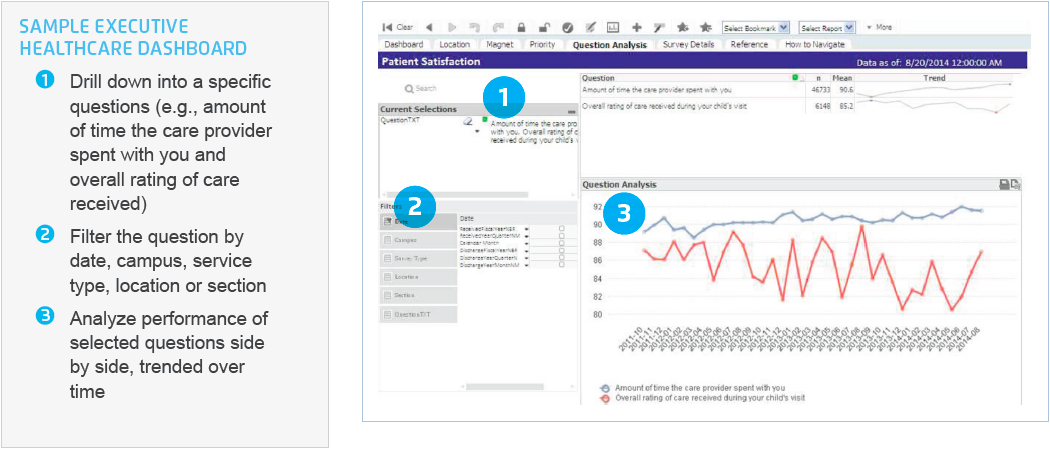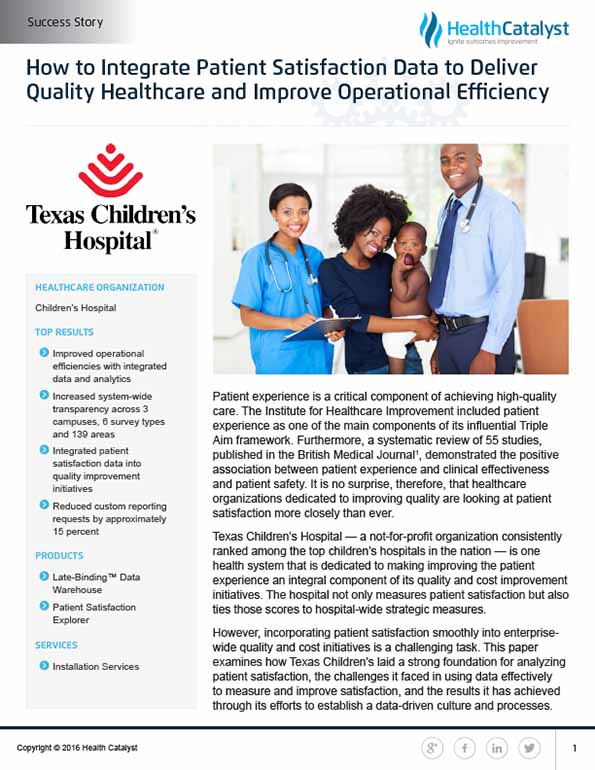Patient experience is essential for high-quality care, as highlighted by the Institute for Healthcare Improvement’s Triple Aim framework. Texas Children’s Hospital emphasizes patient satisfaction by integrating it into quality initiatives, despite challenges in data analysis, ultimately fostering a data-driven culture to improve patient outcomes.
Patient experience is a critical component of achieving high-quality care. The Institute for Healthcare Improvement included patient experience as one of the main components of its influential Triple Aim framework. Furthermore, a systematic review of 55 studies, published in the British Medical Journal1, demonstrated the positive association between patient experience and clinical effectiveness and patient safety. It is no surprise, therefore, that healthcare organizations dedicated to improving quality are looking at patient satisfaction more closely than ever.
Texas Children’s Hospital — a not-for-profit organization consistently ranked among the top children’s hospitals in the nation — is one health system that is dedicated to making improving the patient experience an integral component of its quality and cost improvement initiatives. The hospital not only measures patient satisfaction but also ties those scores to hospital-wide strategic measures.
However, incorporating patient satisfaction smoothly into enterprise-wide quality and cost initiatives is a challenging task. This paper examines how Texas Children’s laid a strong foundation for analyzing patient satisfaction, the challenges it faced in using data effectively to measure and improve satisfaction, and the results it has achieved through its efforts to establish a data-driven culture and processes.
For many years now, Texas Children’s has focused on using technology to help improve clinical outcomes and operational effectiveness. Hospital teams have tackled clinical improvement in such areas as asthma and appendectomy care and operational improvement in areas like labor expenses, clinical documentation and provider productivity. Knowing that the success of these important initiatives depends on data, Texas Children’s has embraced a data-driven culture. When it comes to the hospital’s patient satisfaction initiatives, capturing data has, of course, been key. The Patient & Family Services team that oversaw patient satisfaction was tasked with running custom reports to help hospital leaders understand the organization’s performance in this area. Texas Children’s analysis of patient satisfaction went beyond capturing standard patient satisfaction metrics. The hospital focused on two additional, strategic question categories:
Another important aspect of Texas Children’s patient satisfaction initiative has been transparency to consumers. The hospital shares on its public website five nationally recognized domains of quality and safety for the hospital overall and for multiple clinical programs. Satisfaction scores are also posted in the hallways of the hospital for patients and families to view.
Texas Children’s had established a solid foundation for capturing and sharing patient satisfaction information, but they needed to overcome significant obstacles in order to use this data to drive enterprise-wide improvement. One of the biggest challenges they faced was making patient satisfaction data actionable for the executive team, clinicians and operational leaders. Although these internal audiences had access to high-level information, they did not have an easy way to gain access to granular data that would enable them to analyze their performance. They did not have convenient access to trended key performance indicators across the system or by service units. Nor could they easily drill down and analyze their patient satisfaction data at the individual question level. This situation made it cumbersome and confusing for key personnel to understand question-level or unit-level performance. A further challenge was that leaders could not easily identify Magnet and priority questions using the patient satisfaction vendor’s portal. This was an issue because leaders wanted these questions to be especially visible across the organization, since they represent areas of high strategic importance and strongly impact overall score performance. Unable to conduct analyses on their own, leaders and clinicians relied instead on the Patient & Family Services team to generate customized reports. The frequency of reporting demands taxed this team—and promised to become a significant operational problem with HCAHPS reporting requirements for pediatrics on the horizon. Knowing that the process was unsustainable, hospital leaders sought another solution. They knew that the ability to view and analyze the data at a more granular level was essential for pinpointing specific opportunities to improve patients’ and families’ experience. What they needed was a solution that allowed systemwide access to data in a format that was easy to consume and analyze.
Texas Children’s had previously deployed an enterprise data warehouse (EDW) platform and analytics applications from Health Catalyst to drive operational efficiencies and clinical improvement in many areas. Leaders determined to use this same platform to measure and improve patient satisfaction, enabling many of their key operational metrics to be on one platform and facilitating seamless workflows for leaders as they monitor all of their metrics. The EDW had already integrated several of the hospital’s different data sources: clinical, financial and operational. Texas Children’s and Health Catalyst integrated patient satisfaction data into the existing EDW platform by simply creating a patient satisfaction data mart. Then, the team deployed the Health Catalyst Patient Satisfaction Explorer application to run on top of the platform. The application enables users to view up-to-date patient satisfaction information at any time and, most importantly, to understand the drivers behind patient satisfaction trends. It delivers a dashboard that displays patient satisfaction scores for each of the five areas targeted by Texas Children’s: ambulatory surgery, medical practice, outpatient, pediatric inpatient and emergency center. At one glance, users can see these scores in comparison to organizational goals. The current score for each unit, along with the unit-specific goal and trend lines over time, can be displayed (see Figure 1).

As shown in the sample visualization, the application flags Magnet and priority questions so that users can easily identify them. Moreover, users can filter the Magnet and priority questions by a number of variables including data, campus, survey type (e.g., billing, inpatient, ambulatory), location and section (e.g., nursing care). The application also enables Texas Children’s to easily change or update Magnet and priority questions as needed.
Importantly, the Patient Satisfaction Explorer application is able to meet the needs of different user types and different hospital departments. Users can customize the application and they can filter the data by area, by initiative or by section (e.g., nursing, provider).
They can also track, trend and drill down to look at specific question performance and comments related to their particular area, as shown in Figure 2.

Texas Children’s patient satisfaction data is now integrated into the EDW platform and available for use by any analytics application running on the platform. This consolidation of data into a single source of truth is helping the hospital achieve its systemwide initiative to eliminate the use of vendor portals, driving operational efficiencies and effectiveness. Executive team members, clinical and operational leaders can now view the data in the form of easily accessible, visual reports. They can also filter and drill into the data to perform detailed analyses. Access to the Patient Satisfaction Explorer application and its ease of use is driving broader interest in patient satisfaction and is encouraging more detailed reviews of the data. Examples of initiatives where patient satisfaction has been tracked as a key measure of success using the application include:
All levels of the organization now have full transparency into how their performance is being measured. Personnel across the hospital’s three campuses, 28 survey types, and 139 locations have access to the data and are empowered to discover how to improve their patients’ experience. As a result, physicians and clinicians have become more engaged in patient experience as a measure of quality and can more clearly see the benefits of their efforts with patients. In addition, Magnet and priority questions are now easily visible to users. Although it wasn’t possible to flag these important questions in the patient satisfaction vendor portal, they are clearly marked in the EDW. Operational leaders and clinicians can analyze these specific responses in detail to help the organization reach its patient satisfaction goals.
The EDW aggregates data from a variety of hospital systems, including clinical, financial, operational—and now patient satisfaction. Because this data is housed in the EDW, Texas Children’s can now integrate patient satisfaction data into many of its quality improvement initiatives. Some examples of analyses that Texas Children’s can perform include:
Reporting performed by the Patient & Family Services team that was previously requested from all levels of the organization has now been reduced by an estimated 15 percent, because users are now able to answer questions on their own using the extensive drilldown and filtering capabilities in the application. Since data can automatically be pulled into other quality improvement initiatives through the EDW, the team doesn’t need to devote resources to that process either. This has freed up the Patient & Family Services team to focus their efforts on other strategic areas such as official Magnet reporting and hospital performance reporting.
“The EDW has brought a whole new level of transparency to patient satisfaction in our organization. Now clinicians, operations personnel and executives throughout the hospital have access to dynamic data—and they can customize their views to see the information that interests them in the format they want to see it. The process is much more user friendly and effective than what we had in the past.”
– Ashley Simms, Senior Project Manager
The hospital is well positioned to have patient satisfaction scores increase in the near term and to have high baselines when the HCAHPS regulatory requirements and pay-for-performance kicks in. Texas Children’s will continue to integrate patient satisfaction into additional clinical and operational improvement initiatives such as surgical transplants, diabetes care, practice management and more.




